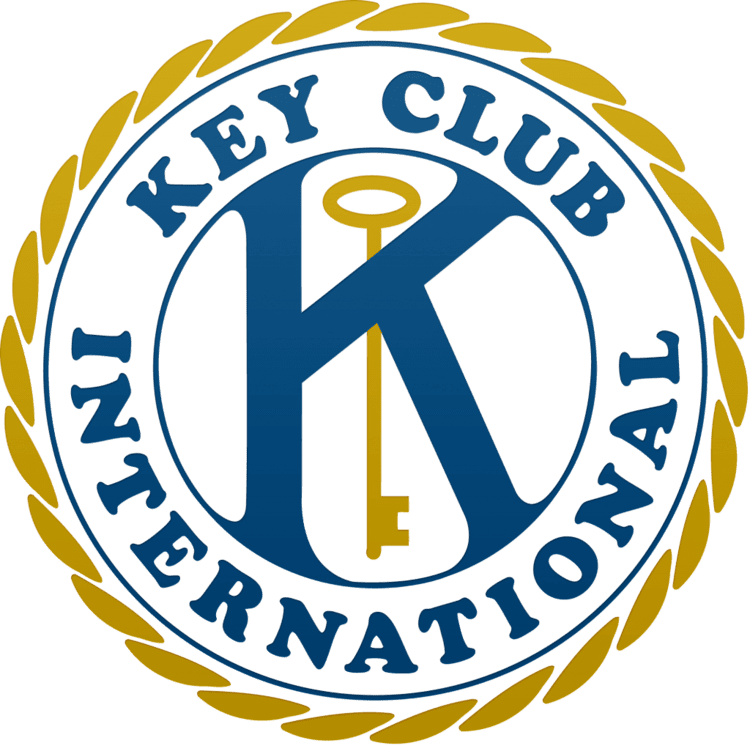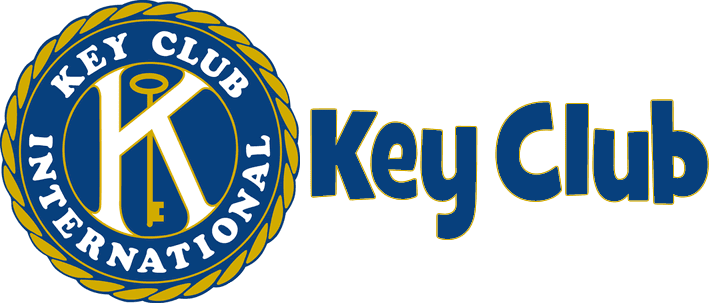Type Service Founded 1925 Owner Kiwanis | Area served Worldwide Motto Caring - Our Way of Life Origin Sacramento | |
Focus Leadership, Character Building, Caring, and Inclusiveness Similar Kiwanis, Circle K International, FBLA‑PBL, National Beta Club, FCCLA Profiles | ||
Mark keppel key club 2015
Key Club International, founded in 1925, is the oldest and one of the largest service programs for high school students. Often referred to as simply Key Club, it is a student-led organization whose goal is to encourage leadership through servicing others. Key Club International is a part of the Kiwanis International family of service-leadership programs. Many local Key Clubs are sponsored by a local Kiwanis club.
Contents
- Mark keppel key club 2015
- 2016 key club international convention recognition session
- Activities
- Theme of the Major Emphasis
- Service Initiative
- Key Club Week
- Structure
- Objectives
- Pledge
- International
- District
- Division
- Origin
- Present status
- Notable former Key Club members
- References

The organization was started by California State Commissioner of Schools Albert C. Olney, and vocational education teacher Frank C. Vincent, who together worked to establish the first Key Club at Sacramento High School in California, on May 7, 1925. Female students were first admitted in 1977, ten years before women were admitted to the sponsoring organization, Kiwanis International.

2016 key club international convention recognition session
Activities
Key Club offers a range of services to its members: leadership development, study-abroad opportunities, vocational guidance, college scholarships, a subscription to the Key Club magazine, and liability insurance.
In 2002 Key Club officially adopted "caring, character building, inclusiveness, and leadership" as the core values of the organization.
Theme of the Major Emphasis
At Key Club International's first convention in 1946, the organization was given the responsibility of instituting a program that would bring together all Key Club's direct members' efforts and energies into an area that would truly make an International impact. This tradition is still followed through the development of the Major Emphasis and its Theme.
"Children: Their Future, Our Focus" is Key Club International's Major Emphasis theme. Officially, any project conducted by members or clubs that serve needy children locally or globally is considered a project of the Major Emphasis. The three preferred charities of Key Club International are paramount to the organization's success in serving children. These are the U.S. Fund for UNICEF, March of Dimes, and Children’s Miracle Network Hospitals. Key Clubs contribute to a global organizational total of more than 12 million hours of hands-on service and millions of dollars donated to the aforementioned partners and other programs.
Recently, the Kiwanis International has dedicated itself to eliminating the risk of Maternal/Neonatal Tetanus (MNT) from the face of the earth. The disease plagues mothers and newborns in 40 countries worldwide, and while an effective vaccine has been developed, MNT claims nearly 100,000 lives each year. As part of the Kiwanis International mission to end MNT, Key Club International has pledged all proceeds from its members' Trick-or-Treat for UNICEF projects to the $110 million funding gap the Kiwanis International Foundation is working to correct.
Service Initiative
The Service Initiative is a program encouraging hands-on service to children aimed towards a common goal. It is changed every two years by the International Board of Trustees.
The 2004–2006 Service Initiative was "Child Safety: Water, Bike and Car Safety", where Key Clubbers participated in different educational events to try to spread safe habits to prevent accidental deaths.
The 2006–2008 Service Initiative was "High Five for Health". It is aimed at reducing childhood obesity and fighting a rising trend that appears to increase the risk of diabetes and heart disease.
The 2008–2010 Service Initiative is "Live 2 Learn". It is focused on 5-to-9-year-old youth, with the main goals of promoting education and building literary skills.
In 2011, the Service Initiative concept was abolished by a vote of the Key Club International Board. It was decided that the freedom of selecting any project in keeping with the theme of "Children: Their Future, Our Focus" would allow for greater success for member clubs and their dedications to service.
Key Club Week
During the first week of November, known as Kiwanis Family Month, Key Clubs worldwide celebrate Key Club Week. In seven days, Key Clubs are encouraged to grow and serve through themed days like "Show Your K in Every Way", "Konnect the Ks", "Kudos to the Key Players", and more. The week has been designed to become the organization's primary membership drive worldwide with the belief that more members will translate to more service and even greater results in serving the children of the world.
Structure
The Key Club District organization is patterned after the original Florida District and its parent Kiwanis districts. These organizations hold their own annual conventions for fellowship, to coordinate the efforts of individual clubs, to exchange ideas on Key Clubbing, and to recognize outstanding service of clubs or individuals with appropriate awards.
Key Club exists on more than 5,000 high school campuses, primarily in the United States and Canada. It has grown internationally to the Caribbean nations, Central and South America, and most recently to Asia and Australia. Clubs exist in Antigua and Barbuda, Aruba, Australia, Bahamas, Barbados, Bermuda, Canada, Cayman Islands, China, Colombia, Costa Rica, Dominica, Ecuador, England, Germany, Guadeloupe,Guyana, Hungary, Italy, Jamaica, Malaysia, Martinique, New Caledonia, New Zealand, Panama, Philippines, Singapore, South Korea, St. Lucia, Taiwan, Thailand, Trinidad and Tobago, Turks and Caicos Islands, the United Arab Emirates and the United States of America.
Key Club International is an organization of individual Key Clubs and is funded by nominal dues paid by every member. Its officers are high school leaders elected by the members at district and international conventions.
The official colors are blue, gold and white.
Objectives
The Objectives of Key Club are listed below. The sixfold sixth objective of Key Club incorporates the Six Permanent Objects of Kiwanis International as adopted in 1924:
The organization maintains partnerships with UNICEF, AYUSA Global Youth Exchange, the March of Dimes, and Children's Miracle Network Telethon. Through the partnership with UNICEF, a major initiative was launched in 1994 to address HIV/AIDS education and prevention in Kenya.
Pledge
I pledge, on my honor,
to uphold the Objects of Key Club International;
to build my home, school and community;
to serve my nation and God;
and combat all forces which tend to undermine these institutions.
International
Key Club International encompasses all clubs within the organization's 33 organized districts and in foreign countries that are not included in any specific district. Key Club International is led by the International Board of Trustees, which is typically composed of the International President, International Vice-President, and 11 International Trustees (Trustees being assigned to three districts and also assigned to serve on various committees within the board). Furthermore, the International Council is composed of the International Board, as well as the District Governor from each of the 33 organized Districts. International Board members are elected at the annual international convention, also known as ICON.
District
A Key Club district is normally defined by state or nation and tends to match a similar Kiwanis district. Each district is chaired by a Governor, elected by delegates to an annual convention. The district is divided into divisions which tend to, but do not necessarily match Kiwanis divisions.
Each District and District-in-Formation is led by a group of students comprising the District Board of Trustees. The Executive District Board commonly includes the Governor, Secretary, Treasurer (or Secretary-Treasurer), and Editor. Each District Board also includes one Lieutenant Governor per division to serve the geographically smaller areas. Whereas one Governor may oversee the operations of an entire district (often the size of one or more states in the United States or a nation in the Caribbean), Lieutenant Governors oversee areas typically including 4–15 clubs. All officers are elected by the students they serve.
A district convention is held each year in each district. Key Club members, advisers, Kiwanis members, and guests attend. A convention center has been required to host all members for general sessions. Activities often include: forums or workshops, which are facilitated by Lieutenant Governors, district executive officers, and sponsoring adults; an awards ceremony; the Governor's Ball or a less formal district dance; and a keynote speaker. Caucuses are held to elect the new District Executive Officers for the upcoming service year.
Many districts have elected to brand their conventions differently, in order to better reflect the events' goals. For example, district convention is referred to as "District Leadership Conference" in the Missouri-Arkansas District, "District Educational Convention" in the New England District, "District Leadership Training Conference" in the New York District, and "District Convention/Leadership Conference" in the Pennsylvania District.
Division
Districts are divided into multiple smaller geographic regions called divisions. Each division is made up of several clubs and is led by a single Lieutenant Governor.
Lieutenant Governor
A Lieutenant Governor (also referred to as Lt. Governor or LTG) is elected to lead and represent a single division in a district. The Lt. Governor serves as a liaison between individual high school clubs in his or her division and the district board. In addition to fulfilling the responsibilities of a Key Club member, Lt. Governors must also visit each of the clubs they serve, publish a monthly divisional newsletter, hold regular Division Council Meetings or Officer Council Meetings, collaborate with other Lt. Governors to organize training conferences, and keep in contact their with clubs, district executive board, and Kiwanis counterparts. A Lt. Governor may initiate community service projects to help the members of the division become more involved. A Lt. Governor may choose to create a division leadership team to delegate some of these responsibilities.
The Lt. Governor is responsible for oversight of, on average, 4–15 high school Key Clubs. One of the Lt. Governor's duties is to plan an election to determine his or her successor near the end of his or her term.
The Lt. Governor's role on the District Board is to act as a representative of his or her governing division. Lt. Governors make up the majority composition of the district board, with over sixty members in some larger districts. Changes and adoption of policies are debated by the board and can be approved by a simple majority vote.
Origin
In California, during the 1920s, adults were concerned with the pernicious side of high school fraternities and sought some means of replacing them with more wholesome activity for youth. In 1924, the local Kiwanis Club decided to attempt to begin a service club at the Sacramento High School, and the school principal eagerly supported the idea and began searching for students willing to start establish the club. In May 1925, a group of boys at Sacramento High School held their first club meeting. Called the "Key Boys", due to their valiant doings, the club eventually became known as Key Club and was associated with Kiwanis International.
Present status
Key Club International now includes 36 organized districts.
As of 2013, Key Club International included more than 265,000 members, approximately 50% of Kiwanis International Family membership.
Key Club International itself employs three full-time staff members and utilizes the services of the nearly 120 more specialists employed by Kiwanis International. All work at International Headquarters in Indianapolis, Indiana.
